
10 Features a Birdhouse Should Have
|
Many birdhouses sold are unsuitable for birds. Outlined below are 10 features that a birdhouse should have. A summary table of favourable and unfavourable features can be found at the bottom of the page. |
Entrance Hole Size |
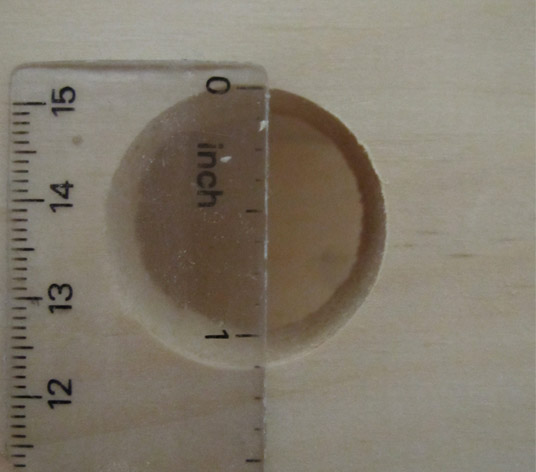 | | Measuring an entrance hole |
|
The entrance hole is the most important feature when looking for a birdhouse. The hole size ultimately determines what birds will find the house favourable to occupy and can deter many predators from using your birdhouse.
When woodpeckers make nesting cavities, the hole size is rarely smaller than 11⁄2" wide. While this is what is found naturally, it is advantageous to use a smaller entrance hole to protect the small birds from larger bully birds such as starlings or house sparrows.
The birdhouse to the left was used for wrens and chickadees. Therefore, a 1 11⁄8" hole was used. For a list of favourable hole sizes for cavity dwelling bird species, see the Birdhouse Measurements page.
|
Interior Dimensions
|
Proper depth and size will encourage favourable songbirds to nest, and discourage predators from gaining access. The interior volume should be large enough to accommodate the movement of adult birds as they bring food for their young. If the birdhouse is small and restricted it can wear away the adult's feathers.
Interior dimensions too large for a particular bird species may cause it to spend a larger than normal amount of time finding extra nesting material. A larger interior volume will also entice unwanted guests such as red squirrels and chipmunks to chew at the entrance hole to make it large enough to fit inside.
For a list of dimensions for cavity dwelling bird species, see the Birdhouse Measurements page.
|
 |
| Measuring the interior dimensions |
|
Ease of Opening
|
 | | This birdhouse is opened from the top |
|
Easy access for maintenance and monitoring is extremely important. The main reason birds choose not to return to a birdhouse after they have used it once, is that they can find an alternative cavity which is free of nesting material. Less time is required to build a nest if the cavity is already clean. If the birdhouse can be taken down and opened with ease, cleaning is much easier and the birds are more likely to return.
Many birdhouses open from the side, but some offer access from the front or top.
The likelihood of disturbing nesting birds when monitoring is greatly decreased when birdhouses are opened from the top are used. Birdhouses that open from the bottom should be avoided as they may result in the nest falling out
If the birdhouse is cleaned out after each bird has fledged, multiple birds may use the birdhouse throughout the spring and summer. Birds generally will not use old nesting material from another family of birds. If there are no other empty cavities available they will clear out old nests and build their own. Therefore, if you clean out old nests as soon as the birds have fledged, you are more likely to get more use out of your birdhouse.
|
Construction Materials
|
Untreated, scent free wood is ultimately the best material from which to construct a birdhouse. Do not use treated wood as it is thought to be toxic and birds generally avoid birdhouses with strong scents. Other materials that are toxic or stained with toxic materials are harmful to the birds and should be avoided. Pressure-treated lumber or paint which gives off volatile organic compounds (VOCs) after it is dry should not be used.
While cedar is rot resistant and is used widely in birdhouse construction it should be avoided because cedar takes time to outgas. Songbirds will avoid nesting in cavities of cedar trees, and for this reason cedar is not recommended for birdhouse construction.
|
 |  |
| Cedar birdhouses take years to offgas |
Avoid birdhouses with asphalt roofs |
|
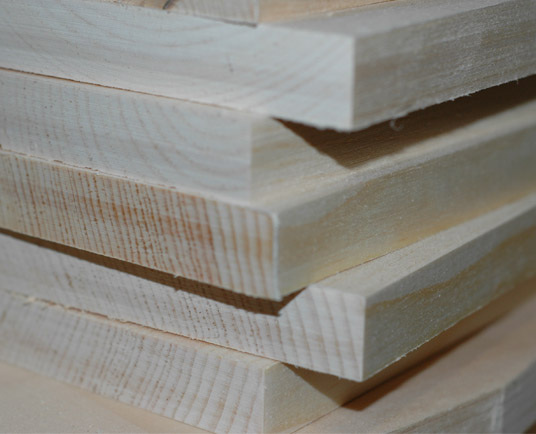 | | Pine for building birdhouses |
 |
| Hardwoods for building birdhouses |
|
Metal birdhouses, or birdhouses with metal or asphalt roofs should also be avoided as the roof can heat up in the summer months and provide no insulation from extreme temperatures. Gourds from the squash species Lagenaria siceraria have also been used as birdhouses in the past. Completely removing the interior organic matter without making the entrance hole too large is key. Gourds do not last long unless they are coated with a preservative. Without an easy way of removing nesting material, it is difficult to remove the nest after the young birds have fledged, making many gourd birdhouses one-time use.
Gourds make good single-use birdhouses and can be a great experience for children. Planting the seeds, growing and harvesting the gourds as well as preparing them for bird families is fun for the whole family!
Lumber that is ¾" thick or greater is a good choice as it shelters the occupants from extreme heat or cold. Wooden birdhouses provide the best insulation in extreme weather conditions. Metal will become too hot during the summer months when the birds are raising their second or third set of young.
Finished pine is easy to coat with a non-toxic preservative and creates a 'new' appearance. Unfinished pine requires a lot of preservative to coat with it is uneven surface (high surface area) but is easier for birds to grasp onto if they are fledging from inside the birdhouse. Hardwoods stand the test of time better than softwoods such as pine or spruce but are often more expensive.
|
Mounting Method
|
Ideally, birdhouses should be mounted in such a way that makes them easily accessible to check on the young as well as maintain and clean. A mounting bracket is light and easy to hold while you are initially mounting it, unlike an entire birdhouse.
The mounting bracket makes it easy to maintain one birdhouse, and is extremely beneficial when many birdhouses are required to be checked on or cleaned out throughout the season. With the mounting bracket seen on the right, there is no need for a screwdriver or handheld drill as the birdhouse can be removed by pushing the entire birdhouse upwards.
See the Placing and Mounting Birdhouses page for more information.
|
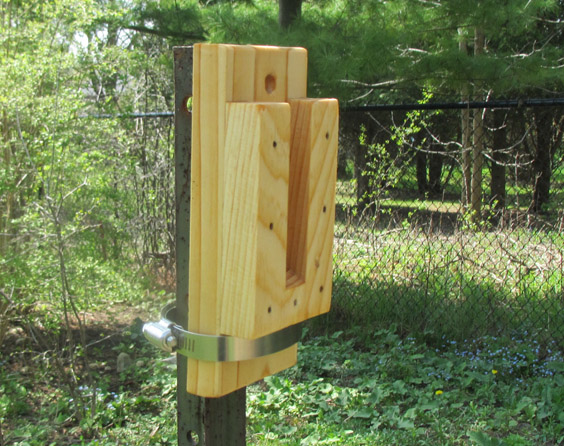 |
| A wooden mounting bracket attached to a post |
|
Ventilation Holes (Climate Dependent) |
Holes drilled at the top of the birdhouse body allow hot air to escape during extreme heat conditions. Birdhouses mounted in warmer locations will benefit from ventilation holes, while birdhouses mounted in more northern climates will benefit from the lack of ventilation holes. Often the entrance hole allows for enough air circulation in northern climates.
The Peterson Eastern Bluebird birdhouse (seen below) has half inch ventilation holes to allow air circulation throughout the birdhouse.
|
Roof Overhang |
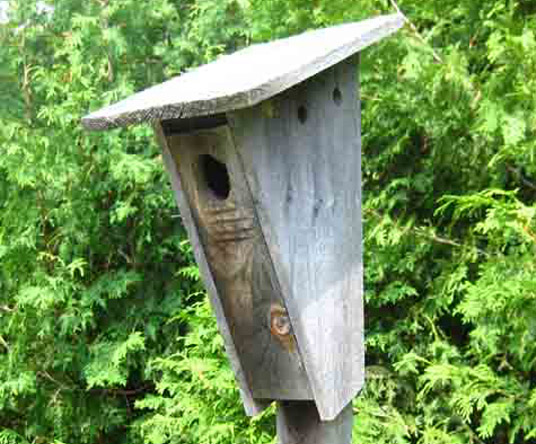 | | Peterson Bluebird Birdhouse with large roof overhang and ventilation holes |
|
A roof overhang will help cool or shade the birdhouse body in the hot summer months, especially in warmer climates. Roofs should extend at least one inch from the birdhouse body. Larger overhangs are optimal as the entrance hole size increases. Larger roof overhangs will minimize the amount of moisture to enter the birdhouse. Excess moisture inside the birdhouse should be avoided. When moisture does find it is way inside the birdhouse, it is important that it can quickly escape through drainage holes.
Tin and asphalt shingle roofs should be avoided as they heat up greatly in the summer sun. One of the distinguishing features of the Peterson Eastern Bluebird birdhouse is its large roof overhang (as seen to the left). Not only does this prevent moisture from reaching inside, but it discourages mammals from reaching inside and disturbing the young.
|
Drainage Holes
|
As discussed above, properly built birdhouses should have minimal moisture making it its way inside the nest. When there are harsh storms and moisture manages to find its way inside it is important that there are ample drainage holes in the bottom to allow moisture to escape. Birdhouses lacking ample drainage are more likely to have their bases rot out prematurely.
Multiple holes should be used in case some holes get packed with nesting material. Holes that are aligned next to the side of the birdhouse body, (See image right) allow moisture to escape faster than those that are only found in the center of the birdhouse.
|
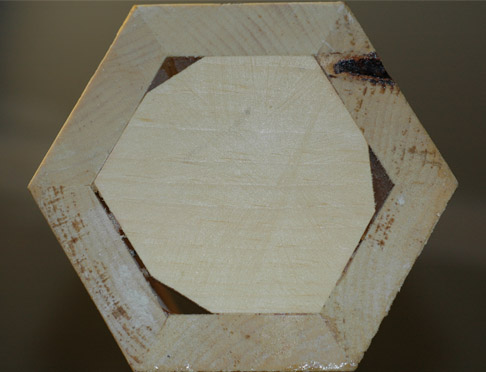 |
| This birdhouse has ample drainage |
|
Floor Joint |
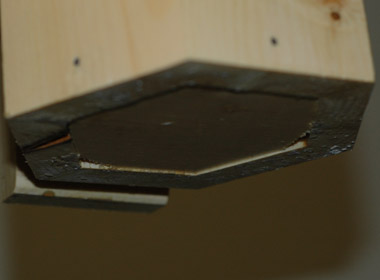 | | Bottom board of a birdhouse enclosed by the birdhouse sides |
|
To ensure your birdhouse lasts over a decade, there are a few tricks that should be used to prevent the birdhouse from rotting out prematurely. A large portion of the rain will drip from the bottom board of the birdhouse. If the wooden birdhouse has end grain exposed on the bottom board, the water is likely to seep in once the waterproof preservative wears off.
To prevent the bottom floor of the birdhouse from rotting out prematurely, the sides should enclose the floor as seen in the diagram to the left. This enables rain to run off the sides.
|
Staining, Painting or Preserving
|
While a painted birdhouse may be aesthetically pleasing to the homeowner, it may not be favourable for future occupants. Many paints take time to out gas even if they are only used on the exterior. If a birdhouse is painted, it should be painted a light colour to increase its albedo and reflect heat. A darkly painted box will absorb unwanted heat in the summer.
Non-toxic water-based urethanes,such as PolyWhey exterior caspian clear, are non-toxic waterproof coatings that give a durable finish and are safe for the birds inside. This particular coating (seen right) is water-proof, UV resistant and is produced by Vermont Natural Coatings. We have found this coating to be the best non-toxic coating with which to coat birdhouses.
Tung oil can also be used to coat the exterior of the birdhouse, but the finish is water resistant and wears off after one season. Yearly applications are required.
|
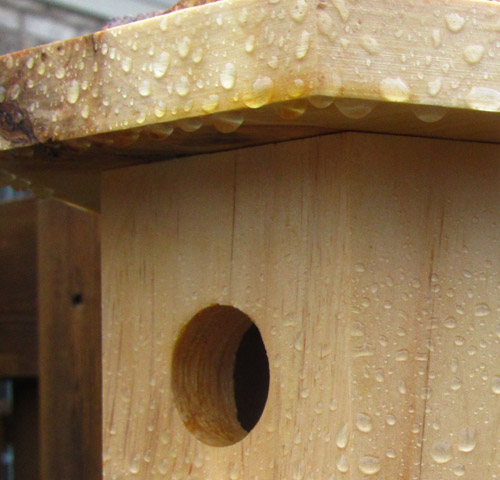 |
| Clear preservatives works better than dark paint |
|
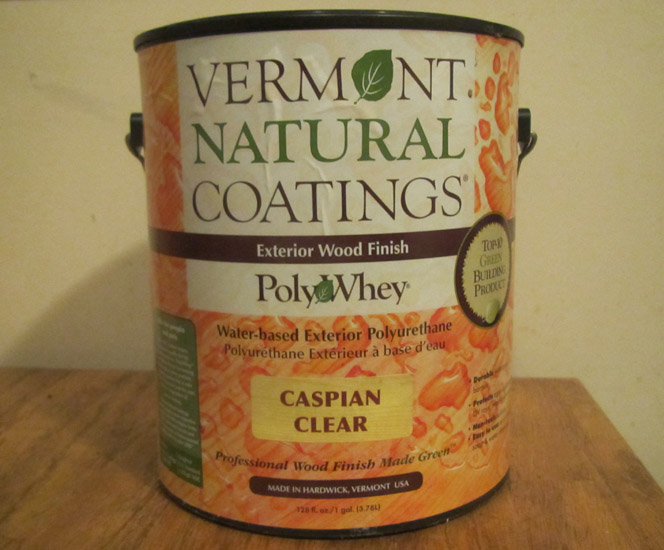 | | Exterior Grade PolyWhey by Vermont Natural Coatings |
|
The interior of birdhouses should never be coated with paint or a preservative of any kind. Extra coating can be applied to the backside of birdhouses. The areas to which the birdhouse is mounted do not dry out as quickly as the rest of the birdhouse after precipitation.
It has been shown that birds prefer weathered birdhouses. This may be due to the toxicity of birdhouses freshly coated with paint and/or urethane. If you are OK with letting your birdhouse weather and decay, the birds will be happy to use it for as long as it provides them with a safe cavity.
If you would like to preserve your birdhouse and get the maximum amount of years from it, be sure to use a non-toxic wood preservative. Coat your birdhouse every few years or as often as you deem necessary.
|
Additional Feature: Perch
|
|
Perches have been demonized for allowing predators such as starlings or house sparrows to gain a greater grip on the birdhouse and cause harm to the young inside. On larger birdhouses with larger entrance holes, this is a concern. As a result, birdhouses of all sizes are being made without perches below the entrance hole. This is being done in spite of a lack of evidence that birdhouses with a perch have a lower fledgling rate. Birds are able to enter a birdhouse without a perch, but prefer to nest in a birdhouse with a perch.
|
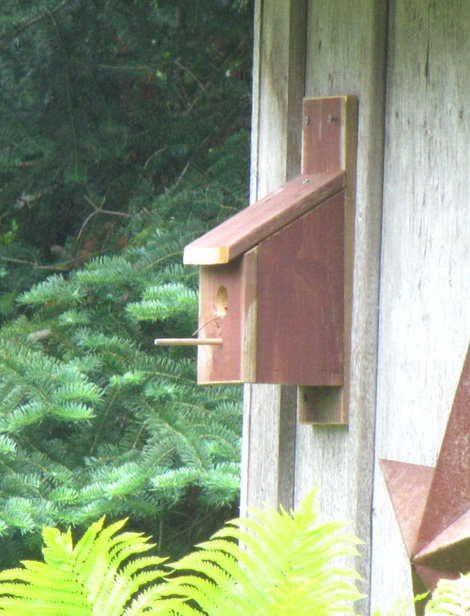 |
| Birdhouse with a large perch |
|
Birdhouses with an entrance hole of 1 1/8" or less are small enough to exclude the heads of predatory birds. Experiments in two locations were conducted with the hexagonal birdhouse to determine if predation is a problem, and if birds prefer a perch. Every year we have found that when two birdhouses are identical except for the presence/absence of a perch are compared, the chickadees and wrens have always picked a birdhouse with a perch. No young have been lost due to predation.
Perches may be preferred by these chickadees or wrens for multiple reasons. One possible explanation could be because perches may make it easier for a bird carrying larger nesting material to land before pushing the nesting material inside. Perches may also be preferred because the bird prefers to examine its surroundings from the viewpoint of the perch before entering the birdhouse.
It should also be noted that there are often branches or coarse bark around the entrance of natural cavities as a result, birds are able to land on these 'natural perches' before entering their nesting cavity.
|
Additional Feature: Viewing Window |
|
Inserting 'viewing windows' of glass or transparent plastic is a recent trend that has its drawbacks. These birdhouses lack the insulation that wood provides on the side that contains the glass or plastic. Cats and other predators may be attracted to the viewing windows and cause problems when the birds start to fledge. |
Some birdhouses offer a one way mirror that allow an outside viewer to see inside. The interior mirror may also create stress for the birds when they see their own reflection.
Both viewing window and one-way mirror style birdhouses should be avoided as they can allow extra light to reach the inside of the birdhouse and can make it easy for predators to see inside.
A small video camera is an alternative to viewing windows that allows the birdhouse to retain wooden walls but allows others to view the inside of the birdhouse without causing stress the birds. For more information on setting up your own birdhouse camera, see the Hexcam Setup page.
|
 |
| Small video camera in birdhouse roof |
|
Additional Feature: Multiple Levels and Entrance Holes |
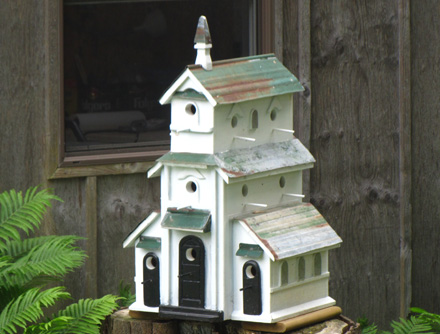 | | Purple martin birdhouse with multiple compartments and entrance holes |
|
Purple martins are the only bird species in North America that prefer to share birdhouses with other birds and can reside in a multi-compartment birdhouse. These birdhouses often contain multiple levels and entrance holes. They must be placed high in an open field which makes them difficult to maintain and mount.
Most other songbirds do not like to share nesting cavities, and are often territorial. As a general rule of thumb, birdhouses should be placed at minimum 3 m (10') apart. For a more detailed summary on how closely birdhouses should be mounted, see the Placing and Mounting Birdhouses page for more information.
|
Birdhouse Feature Summary |
|
After researching many designs and reading many scientific journal articles it has become apparent that there are many flaws in current birdhouse models on the market for small songbirds such as chickadees and wrens. The aim is to provide birdhouses with as many favourable attributes as possible to give the birds a better chance, and make it easier for the care taker.
|
Feature |
Favourable |
Unfavourable |
| Body Material |
Pine
Spruce
Composite
Non-toxic hardwoods |
Cedar
Metal
Pressure treated wood
Squash |
| Roof Material |
Pine
Spruce
Composite
Non-toxic hardwoods |
Metal
Asphalt shingle
|
| Preservative |
Non-toxic waterproof urethane
Tung oil
Linseed oil |
Paint
Urethane |
| Drainage Holes |
3+ |
< 3 |
| Nest Clean-out |
Bracket with removable lid |
Hinged side
Hinged roof
Removable back panel
Bottom board |
| Observation Method |
Removal of lid
Hinged roof |
No observation method
Pexiglass walls |
| Mounting Method |
Removable bracket |
Screws in back wall mounting birdhouse
|
| Birdhouse Placement |
Predator-free area |
Within 5 m from bird feeder
Hanging from branch |
Sitemap | In Season | Products | Information | Store | Contact Us

























